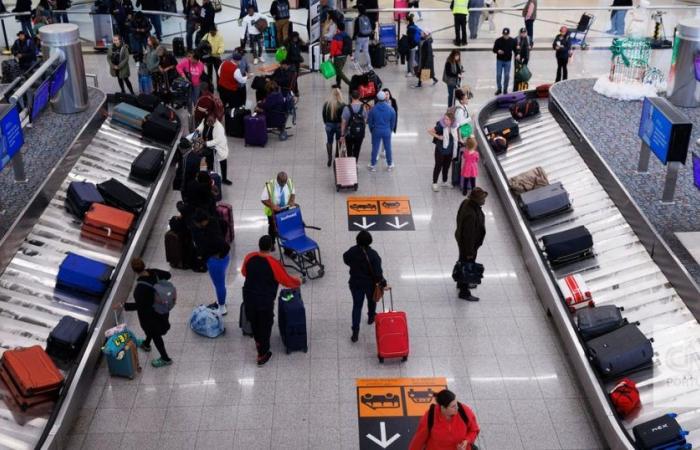Editor’s note: The opinions expressed in this text are the sole responsibility of the author. CNN features the work of The Conversation, a collaboration between journalists and college students to provide news analysis and commentary. Content is produced exclusively by The Conversation
Five of the six largest U.S. airlines have increased checked baggage fees since January 2024.
For example, American Airlines. In 2023, it costs 30 dollars (28 euros) to check a standard bag with the airline; currently, since March 2024, it costs 40 dollars (37 euros) at a US airport – a whopping 33% increase.
As a management professor who studies travel, I’m often asked why airlines turn away customers with baggage fees instead of bundling all the charges together. There are many reasons, but one important, often ignored cause is buried in the US tax code.
A loophole in tax law
Airlines pay the federal government 7.5% of the ticket price when they fly domestically, in addition to other fees. Airlines don’t like these fees, arguing that they increase the consumer cost of a typical plane ticket by about a fifth.
However, the U.S. Code of Federal Regulations specifically excludes baggage from the 7.5% transportation tax as long as “the fee is separate from the payment for transportation of a person and is indicated in the exact amount.”
This means that if an airline charges a total of $300 (282 euros) to transport you and a suitcase round-trip within the USA, you will have to pay $22.50 (21 euros) in tax. If the airline charges $220 (207 euros) for the flight and separately charges $40 (37 euros) for each bag trip, the total cost is the same – but the airline only owes the government $16.50 (15 .54 euros) in taxes. By splitting baggage fees, the airline saves $6.
Now, 6 dollars (5.65 euros) may not seem like much, but it can be very important. Last year, passengers took more than 800 million trips on major airlines. Even if only a fraction of these passengers check their luggage, it means huge savings for the industry.
How big? The government has been monitoring revenue from baggage fees for decades. In 2002, airlines charged passengers a total of 180 million dollars (169 euros) to check their bags, which was equivalent to around 33 cents per passenger.
These days, as any passenger can attest, baggage fees are much higher. Last year, airlines collected more than 40 times as much money in baggage fees as they did in 2002.
When complete data for 2023 is available, total baggage fees are expected to exceed US$7 billion (€6.59 billion), which represents around US$9 (€8.47) for the domestic passenger average. By separating the cost of bags, airlines avoided paying around half a billion dollars in taxes last year alone.
In the two decades since 2002, passengers have paid a total of around $70 billion (€65.91 billion) in baggage fees. This means that charging separately for bags saved airlines around 5 billion dollars (4.71 billion euros) in taxes.
It is clear to me that tax savings are one of the factors driving the separation of baggage fees due to a quirk in the law.
The United States government does not apply the 7.5% tax to international flights that travel more than 225 miles beyond the country’s borders. Instead, there are fixed international departure and arrival fees. That’s why major airlines charge 35 to 40 dollars (between 32 and 37 euros) for checked baggage on domestic flights, but don’t charge baggage fees on flights to Europe or Asia.
Do passengers get anything for this money?
An employee handles luggage at George Bush Intercontinental Airport in Houston, Texas Brett Coomer/Houston Chronicle/Getty Images
This system raises an interesting question: do baggage fees force airlines to be more careful with bags, since customers who pay more expect better service? To find out, I consulted the Department of Transportation Statistics, which has been tracking lost baggage cases for decades.
For many years, the number of reports of lost luggage per thousand airline passengers has been calculated. Government data showed that the number of lost bags peaked in 2007, with around seven reports of lost or damaged luggage per 1,000 passengers. This means that you can expect your luggage to make a different journey to the one you are taking approximately once in every 140 flights. In 2018, this estimate had dropped to once in every 350 flights.
In 2019, the government changed the way it records miscarried baggage, calculating the numbers based on the total number of checked baggage rather than the total number of passengers. The new data shows that around six bags for every thousand registered are lost or damaged, which represents less than 1% of registered bags. Unfortunately, the data shows no improvement since 2019.
Is there anything you can do about the increased baggage fees? Complaining to politicians probably won’t help. In 2010, two senators tried to ban baggage fees, but the bill went nowhere.
Given that Congressional action failed, there is a simple way to avoid higher baggage fees: travel light and don’t check any bags. It may seem difficult not to have all your belongings when traveling, but it may be the best option as baggage fees increase.
Jay L. Zagorsky is an associate professor of markets, public policy, and law at Boston University.
Republished under a Creative Commons license from The Conversation.
Tags: airlines charge checked bags littleknown rule helps explain
--





